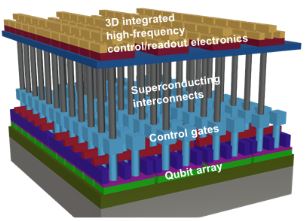Title: EE Professor Kim, SangHyeon’s Research Team Develops 3D Stackable Quantum Computing Readout Device
KAIST Builds 3D Stackable Quantum Computing Readout Device Low-power, low-noise, high-speed device integrated in 3D operates at super-low temperatures and promises large-scale applications to quantum computing devices.

<(From left) EE Prof. Kim, SangHyeon, PhD candidate Jeong, Jae Yong, NanoFab PhD candidate Kim, Jongmin, and KBSI Prof. Park, Seung-Young>
KAIST EE Prof. Kim, SangHyeon’s research team has developed a 3D-stacked semiconductor readout device integration technology, as made public on the 16th. The team made this possible by applying the strengths of monolithic 3D integration to overcome large-scale qubit implementation based on existing quantum computing systems. Their work is a first of its kind exhibiting the 3D stackability of quantum computing readout devices after an actively pursued line of research on monolithic 3D stacking of high-speed devices following a 2021 VLSI presentation, a 2021 IEDM presentation, and a 2022 ACS Nano publication.
(*monolithic 3D integration: dubbed the ultimate 3D integration tech, wherein after the lower-layer devices, the upper layer’s thin film is created and stacking proceeds sequentially so as to maximize the upper-lower device alignment)
KAIST EE Prof. Kim, SangHyeon Kim’s research team member Jeong, Jae Yong led the work as first author, collaborating with NanoFab PhD candidate Kim, Jongmin and KBSI Prof. Park, Seung-Young. Their joint work has been presented at the “semiconductor Olympics”, Symposium on VLSI Technology. (Paper: 3D stackable cryogenic InGaAs HEMTs for heterogeneous and monolithic 3D integrated highly scalable quantum computing system)
A qubit is capable of processing twice the amount computation compared with that of a bit. Number of qubits increasing linearly results in exponential speedup of their computation. Thus, developing large-scale quantum computing is of utmost importance. IBM, for instance, presented Eagle containing 127 qubits, and the IBM roadmap outlines development of a 4,000-qubit quantum computer by 2025 and one with 10,000-qubits or more in 10 years.
Designing such large-scale quantum computers with many qubits requires implementing devices for qubit control/readout. The research team has not only proposed and implemented 3D-stacked control/readout devices but also achieved world-best cutoff frequency characteristics at cryogenic settings despite the 3D stacking.
This work has been supported by the National Research Foundation of Korea, the System Semiconductor Development Program funded by Gyeonggi-do, and the Korea Basic Science Institute.

